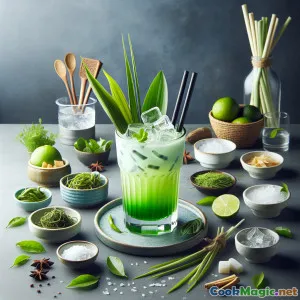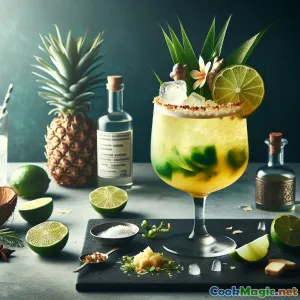
Fizz de creme de coco com pandan e limão-lima
(Pandan Lime Coconut Cream Fizz)
(0 Avaliações)0
77
outubro 30, 2025
Reportar um problema
Ingredientes
-
6 leaves Folhas de Pandan
(Knot and bruise; frozen works fine)
-
1 stalk Capim-limão
(Levemente esmagado para liberar óleos)
-
80 grams Açúcar de palma
(Substitute light brown sugar if needed)
-
250 ml Água
(For pandan syrup)
-
2 tsp Sementes de manjericão (sabja)
(Soak in 100 ml water for 10 minutes)
-
30 ml Suco de Limão Fresco
(About 1 large lime; adjust to taste)
-
120 ml Creme de coco
(Use thick top layer; well chilled)
-
20 ml Leite condensado
(For coconut cream sweetness; or use extra syrup)
-
1 pinch Sal marinho
(Balances sweetness in coconut layer)
-
300 ml Água com Gás
(Well chilled for better fizz)
-
2 cups Cubos de Gelo
(Para resfriar e servir)
-
60 ml Rum branco
(Optional spirited variation (30 ml per glass))
-
1 tsp Sementes de gergelim torradas
(Garnish; or use toasted coconut flakes)
-
2 drops Extrato de pandan
(Only if leaves are unavailable; very potent)
-
1 tsp Raspas de limão
(Ralada na hora para aroma)
(Knot and bruise; frozen works fine)
(Levemente esmagado para liberar óleos)
(Substitute light brown sugar if needed)
(For pandan syrup)
(Soak in 100 ml water for 10 minutes)
(About 1 large lime; adjust to taste)
(Use thick top layer; well chilled)
(For coconut cream sweetness; or use extra syrup)
(Balances sweetness in coconut layer)
(Well chilled for better fizz)
(Para resfriar e servir)
(Optional spirited variation (30 ml per glass))
(Garnish; or use toasted coconut flakes)
(Only if leaves are unavailable; very potent)
(Ralada na hora para aroma)
Nutrição
- Porções: 2
- Tamanho da Porção: 1 copo (300 ml)
- Calories: 220 kcal
- Carbohydrates: 0 g
- Protein: 1 g
- Fat: 8 g
- Fiber: 1 g
- Sugar: 24 g
- Sodium: 60 mg
- Cholesterol: 0 mg
- Calcium: 25 mg
- Iron: 0.7 mg
Instruções
-
1 - Make pandan syrup:
Combine water, palm sugar, knotted pandan leaves, and crushed lemongrass in a small saucepan. Bring to a gentle simmer for 5–7 minutes until sugar dissolves and liquid turns aromatic. Remove from heat, cover, and let steep 10 minutes. Strain and chill.
-
2 - Soak basil seeds and chill glassware:
Soak basil seeds in water until swollen and jelly-like. Meanwhile, place serving glasses in the freezer for a quick chill to help preserve the fizz.
-
3 - Mix salted coconut cream:
In a small shaker or jar, combine coconut cream, a pinch of sea salt, and condensed milk (or 10–15 ml pandan syrup). Add ice and shake briefly to chill and slightly aerate. Keep cold.
-
4 - Build the pandan-lime base:
Add 1 tsp soaked basil seeds to each chilled glass. Pour 45 ml pandan syrup and 15 ml fresh lime juice into each glass. Add ice to the brim. If making it spirited, add 30 ml white rum now.
-
5 - Top with fizz and float coconut:
Gently top each glass with 150 ml soda water, stirring once to combine. Slowly float the salted coconut cream over the back of a spoon to form a distinct creamy layer.
-
6 - Garnish and Serve:
Finish with a sprinkle of toasted sesame seeds and a whisper of lime zest. Optionally, add a knotted pandan leaf as an aromatic stirrer. Serve immediately with a straw.
Combine water, palm sugar, knotted pandan leaves, and crushed lemongrass in a small saucepan. Bring to a gentle simmer for 5–7 minutes until sugar dissolves and liquid turns aromatic. Remove from heat, cover, and let steep 10 minutes. Strain and chill.
Soak basil seeds in water until swollen and jelly-like. Meanwhile, place serving glasses in the freezer for a quick chill to help preserve the fizz.
In a small shaker or jar, combine coconut cream, a pinch of sea salt, and condensed milk (or 10–15 ml pandan syrup). Add ice and shake briefly to chill and slightly aerate. Keep cold.
Add 1 tsp soaked basil seeds to each chilled glass. Pour 45 ml pandan syrup and 15 ml fresh lime juice into each glass. Add ice to the brim. If making it spirited, add 30 ml white rum now.
Gently top each glass with 150 ml soda water, stirring once to combine. Slowly float the salted coconut cream over the back of a spoon to form a distinct creamy layer.
Finish with a sprinkle of toasted sesame seeds and a whisper of lime zest. Optionally, add a knotted pandan leaf as an aromatic stirrer. Serve immediately with a straw.
Mais sobre: Fizz de creme de coco com pandan e limão-lima
Cambodian Pandan Palate: A Fragrant Layered Mocktail That Celebrates Khmer Flavors
The Cambodian Pandan Palate is a glassful of contrast and harmony—fragrant, green, and gently sweet from pandan and palm sugar; bright and zesty from fresh lime; and luxuriously capped with a salted coconut cream float. It brings together a handful of ingredients central to Cambodian pantries and markets, transforming them into a modern, layered mocktail (or cocktail, if you add a splash of white rum) that still nods to tradition.
Why this drink works
- Pandan and palm sugar are natural partners. Pandan—called bai toey in parts of the region—imparts a grassy, vanilla-like aroma that’s as much scent as flavor. Palm sugar adds deep caramel notes with a hint of smokiness, delivering body without cloying sweetness.
- Lime juice adds a bright counterpoint. In a climate where refreshment is essential, citrusy acid tightens the flavors and makes the drink thirst-quenching rather than heavy.
- The salted coconut cream float is the signature. By salting coconut, you amplify its nuttiness, echoing a common Cambodian practice of balancing sweetness with a pinch of salt in desserts and drinks. Floating it atop soda-kissed pandan-lime creates both a visual and textural surprise.
Tips, techniques, and make-ahead notes
- Syrup depth: The longer you steep pandan and lemongrass (off the heat), the fuller the aroma. Ten minutes is a sweet spot, but you can go up to 20 minutes if you want a more pronounced flavor. If you only have pandan extract, start with just a drop stirred into the cooled syrup; it’s potent.
- Prevent curdling: Acidic lime can split coconut if you shake them together. That’s why the coconut cream stays separate as a float. Build the lime-and-syrup base first, top with soda, then gently float the chilled coconut layer.
- Texture add-ins: Soaked basil seeds (sabja) give a gentle crunch and fun, jelly-like texture while remaining neutral in flavor. If unavailable, chia seeds behave similarly, though they create more viscosity.
- Sweetness control: Start with 45 ml syrup per glass, then adjust. Glass size, ice melt, and lime juiciness vary. Because palm sugar differs in intensity, taste your syrup and tweak with a pinch of salt to round off sharp edges.
- Serving temperature: Everything should be well chilled—the syrup, the soda, and especially the coconut cream. Cold temperatures help maintain the float’s definition and keep carbonation lively.
- Alcoholic variation: A clean white rum complements pandan without overpowering it. For something herbaceous, try a light gin; for dessert-like richness, a splash of coconut rum works too.
Cultural context and inspiration
Cambodian cuisine often weaves together coconut, palm sugar, and herbaceous aromatics like pandan and lemongrass, particularly in sweets, puddings, and chilled treats sold at markets. The Cambodian Pandan Palate draws on those familiar flavors while presenting them in a contemporary beverage format.
Palm sugar, tapped from sugar palms and slowly cooked into cakes, is essential throughout Cambodia—its caramel depth shows up in both savory sauces and sweet snacks. Pandan leaves, meanwhile, are prized for their perfumed aroma; you’ll see them knotted into simmering pots of rice or custard, or infused into jellies and cakes. Lemongrass, another market staple, adds a gentle citrusy lift that keeps the syrup nuanced rather than flatly sweet.
The choice to float salted coconut cream nods to the subtle way salt appears in Khmer desserts. That pinch of salt doesn’t make the dish salty; it turns up the volume on coconut’s natural sweetness and adds dimension, much like a chef’s judicious seasoning in savory cooking.
Unique aspects
- A two-part architecture: The fizzy pandan-lime base is light and sparkling, while the coconut float drinks like dessert—a playful push-pull that evolves as you sip and stir.
- Textural delight: Basil seeds provide a delicate, caviar-like pop, offering interest without stealing flavor focus.
- Flexible format: It’s equally at home as a zero-proof refresher or a refined cocktail with rum. The base syrup also keeps for a week, making this drink weeknight-friendly and party-ready.
Serving and pairing ideas
- Garnish thoughtfully: A knotted pandan leaf acts as an aromatic stirrer. Toasted sesame or coconut flakes add nutty aroma that echoes palm sugar’s caramel.
- Food pairings: Try with crispy spring rolls, green mango salad, or grilled skewers with a palm sugar glaze. The drink’s acidity cuts richness; the coconut softens heat.
Final thoughts
The Cambodian Pandan Palate is more than a pretty layered drink—it’s a compact story of place and palate. With familiar Cambodian building blocks arranged in a new way, it invites you to sip slowly, breathe in the pandan’s perfume, and appreciate how a pinch of salt can make coconut sing. Whether you keep it alcohol-free or give it a celebratory lift, this glass brims with balance, culture, and refreshment.

















